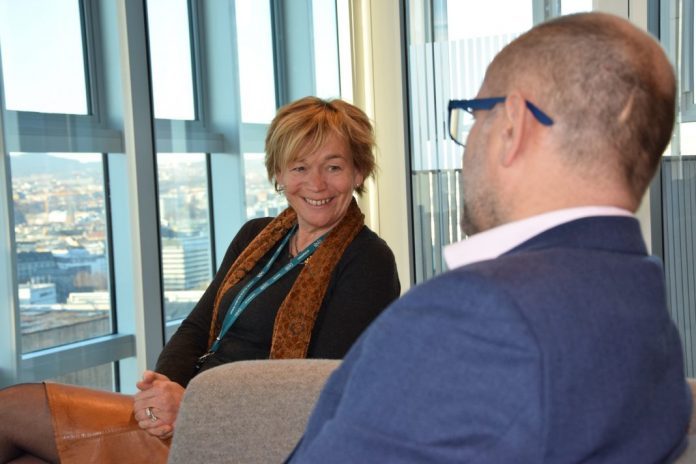DNB Head of Foods and Seafood Anne Hvistendahl and Senior Vice President Dag Sletmo see the potential for land-based in Norway across three fronts.
“Previously, we laid the criteria that land-based food fish production had to be done abroad, far away from Norway. Having the air freight cost buffer by producing close to the markets we saw as crucial. The thinking is somewhat more nuanced today,” said Hvistendahl.
The other two criteria stand by to get DNB on the team. One must have a technology that one has a good basis for believing that will work, and the actors must be of an industrial character. And have the necessary knowledge.
“You do not get the transport buffer by producing in Norway. But industrial players are equally important, and we have that here in the country. Although we do not have any proven technology for land-based food fish yet, it is increasingly being tested on smolt, so one now knows that it works to some extent. And there are a number of players already producing full cycles on land, but with very low volumes. Driving things on a large scale is always much more demanding,” said Hvistendahl.
Technology
DNB also thinks that the fact that Norway can be used as a technology hub for the development of land-based fish is the first potential exciting opportunity.
“Then I think, for example, of what we now see in Fredrikstad. That one tries out something on a smaller scale can be expedient,” said Hvistendahl.
The second is to build an “outboard” to an already existing large-scale plant, allowing a portion of the fish to grow into a ready-to-grow size to exploit a niche in the market.
Read more: Danish company opens land-based farm
Throughput Construction
The third interesting front DNB envisages for land-based is the use of through-flow facilities, which are used close to the’s sea proximity.
“Utilizing some of the benefits of being in Norway will be important, also on land. In any case, the most important thing is that the long-term costs are low. But if a license in the sea costs 150-200 million (EUR 20 million) and if you can have a throughput facility where you release the license cost, and also release part of the disease cost in the sea, then it may be relevant,” said Hvistendahl.
She believes the most important thing is to have a project that in the long term will have competitive costs compared to production in the sea.
“A lot of investments are being made in Norway to increase volume, but less to reduce costs. In the long term, I think that the margins are not going to be like today, and then you have to know that it is still going around,” said Hvistendahl.
Will succeed
In the Emirates, they have just harvested their first land-based farmed salmon and several small plants are on the cards, including in Fredrikstad. DNB is not involved in any of these, but they have contributed external funding to the first truly large land facility, Atlantic Sapphire in the United States.
“We think that sooner or later someone will also succeed on a large scale. Atlantic Sapphire has had problems in Denmark, but they have been running for seven years and have shown that what they do has worked to a considerable extent. They have tested and learned systematically. The project in the US has some things that correct for the problems the company has had in Denmark, and which meant that we thought they showed enough that we wanted to join the team,” said Hvistendahl.
DNB has during the past year received a dozen requests for funding for land-based fisheries facilities. So far, only Atlantic Sapphire has received funding from the bank.
“There are several exciting projects with flow-through systems that we are following,” said Hvistendahl.
Black swan
“The small plants are not “game-changers”. We used to say that land-based was a black swan for the industry. Now this swan has grown somewhat, but not so that we are concerned about the Norwegian industry,” said Hvistendahl, who does not believe any success with land-based food fish will be the end of the road for Norway’s aquaculture adventure.
“There are such great benefits in the sea, partly because of energy savings. And the relatively fast export to Europe, which after all is the big market for Norwegian salmon, means that the sea raised will still be strong. But at the same time, it is important to get rid of the biological problems that one might to some extent avoid on land,” said Hvistendahl.


